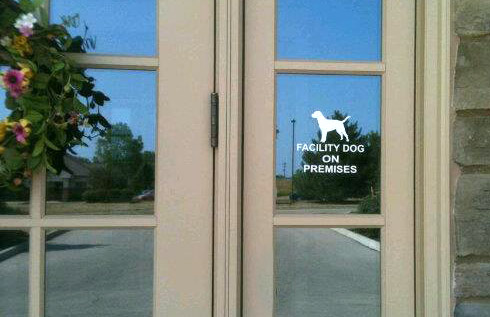Overcoming Resistance
Most people first encounter some resistance to the idea of implementing a Courthouse Dog Program when they first mention it to other staff members. A courthouse has a tradition of decorum and the presence of a dog in that setting seems surprising and unconventional.
After that initial reaction, the notion of dealing with employee’s concerns about allergies, fear or dislike of dogs makes it easy to say no. Other issues that are raised are concerns about the cost or the level of commitment needed to making a program like this work.
Be prepared in advance to address these issues and present documentation of the success of this type of program in other jurisdictions.
Allergic People
Although allergies to dogs are fairly common, few people are affected by encountering a dog in a large, open public area similar to the lobby of a building or a courtroom.
Dog dander, the primary cause of dog allergies, is present in all public places, as it is carried on the clothes of the dog-owning public. Please see this excellent scientific article for further details. Also review Canines in the Classroom: Service Animals in Primary and Secondary Educational Institutions pages 19-22 which also provides research on this topic.
A significant problem may arise if a member of the staff at a facility is allergic to dogs. It will become the dog handler’s responsibility to ensure that the dogs and its environment are managed in such a way as to minimize the problem.
A courthouse facility dog should be impeccably groomed, including being bathed frequently. Between baths, the animal can be wiped down with special pet wipes (available online or in many pet stores) or with baby wipes. Keeping a package of these wipes in the handler’s office will allow the dog to always be as clean as possible.
Rugs and bedding that the dog uses will need to be washed weekly in hot water. If the dog occupies a crate during part of the day (an excellent management tool), the crate will need to be cleaned thoroughly on a regular basis.
Courthouse facility dogs, of course, should be trained to never lick a person’s hand or face. Everyone who handles the dog should be encouraged to wash their hands afterwards when possible.
Fear of Dogs
A certain percentage of people are afraid of all dogs – big or little, friendly or aggressive, active or quiet. Experienced dog handlers are sure to encounter individuals who are afraid of the well-mannered dog at the end of the leash. Some fear of dogs may arise because of confusion in a person’s mind between a “police dog” and a friendly courthouse facility dog. What can be done to minimize the problem for all concerned?
The worst reaction will occur if the encounter with the dog is sudden and unexpected. To avoid this, there are a few simple steps which can be taken by the handler and the program supervisor.
The first line of defense against an unexpected encounter is a picture of the dog posted in a prominent area at the entrance to the building or to the specific area where the dog works. In this way, everyone has at least had some chance to be forewarned that there is a dog present in the facility. If you have reprints of articles about the dogs, or a brochure from the sponsoring organization, leave these out for people the read and find out more about the canine program.

Vinyl cling sign on outside of Michael’s House Child Advocacy Center in Fairborn, Ohio.
Courthouse facility dogs in a legal setting should always wear a vest or other indication of their official status, and should always be on leash when working.
The most important element in avoiding problems for people who are afraid of dogs is for the handler to be aware of her/his surroundings at all times. When possible speak to everyone you encounter who seems interested in the dog; if a person seems concerned, stop some distance away and introduce yourself and the dog. When you are in a large open area, respect the fact that some people may have moved away and may prefer to watch you and the dog from across the room rather than approach. When entering a new room or area, keep your dog on a very short lead until you are sure that everyone present is comfortable.
A handler should remember that not everyone who backs away from a dog is necessarily afraid. There may be allergy problems or religious prohibitions against close contact with dogs; these people may enjoy watching the dog perform commands or play with other people, although they will watch from a little distance.

